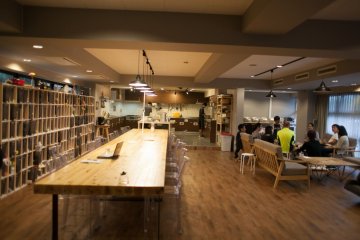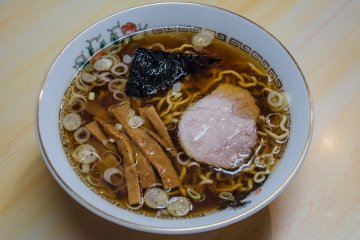
Oakhouse: Social Residence Higashi Koganei
Oakhouse Social Residence Koganei in Tokyo's Koganei suburb is a share house that offers long-term residence to both Japanese and international residents.

In 1993, the seven-acre Edo-Tokyo Open Air Architecture Museum was opened by the Tokyo Metropolitan Government as part of the Edo-Tokyo Museum. The aim of this museum is to preserve historic buildings of great cultural value that are not in their current location can be relocated, reconstructed, preserved and exhibited and this valuable cultural heritage can be passed on to future generations.
The open-air museum offers the following exhibitions: An introduction in the visitor center. Restored buildings and scenes from everyday life in the Edo period. Architectural remnants and recreation of an urban landscape A collection from the Original Musahino Folklore Museum in a special exhibition.
The various exhibitions can be viewed within the exhibition rooms or in the actual open-air museum.

Oakhouse Social Residence Koganei in Tokyo's Koganei suburb is a share house that offers long-term residence to both Japanese and international residents.

SORANO HOTEL overlooks Showa Kinen Park in the Tachikawa area of West Tokyo, offering 81 rooms at the new Green Springs development. All rooms come with park views and boast spacious room sizes of at least 52 square meters. All rooms come complete with balcony space and oversized windows provide plenty of light on the hotel's interiors, produced by French designer, Gwenael Nicolas.

Harmonica Allee is located in the trendy area of Kichijoji and is a section of local izakaya bars that are only a few minutes' walk from the train station. The alleys of Harmonica Allee are narrow and at the same time full of life. There you can find fashion, local market traders, which are open during the day, as well as izakayas and pubs that can be visited until late at night. Since the 1990s, Harmonica Allee has been very popular, especially among the locals, for its stand-up bars with inexpensive snacks in the late evening. The area was named for the way this tight tangle of restaurants, shops, and bars resembles a harmonica. It can get full quickly, but it definitely never gets uncomfortable!

Re:gendo is a cafe, apparel and arts and crafts store found in the quaint backstreets of Nishi-Ogikubo, just a few minutes from the station. It embodies everything about Shimane prefecture, capturing the essence of its history, culture and beauty that help inspire everything on offer here. Located in a spectacular wooden structure, which is said to be around 90 years old, Re:gendo is an homage to Shimane and the staff and owners take great care to display the cultural history of their beloved homeland. It’s a curious space, layed out over two floors. It acts as a thriving restaurant, apparel store, arts and crafts shop and a workshop space which focuses on teaching craftsmanship and culinary skills. The cafe recognizes the nuances involved in Shimane produce such as rice which it uses for its extremely popular, seasonal lunch menus musubi zen and nigiri zen. Musubi zen consists of a main fish or meat dish while nigiri showcases vegetable nigiri sushi. Both courses come with accompaniments including vegetables, pickles and miso soup. The ingredients at Re:gendo are sourced locally in Toyo or from Shimane. The cafe also does a fine collection of sweets (Shimane folk are particularly fond of wagashi or traditional Japanese confectionery). The apparel and crafts section, situated on the first floor adjacent to the cafe includes a range of arts and crafts from Shimane and a curated fashion line which uses a type of non-toxic dye from Shimane so it’s safer for pregnant women or customers with allergies. The second floor hosts regular workshops about local craftsmanship and cuisine. Visitors from all over the world come and participate in workshops and learn the intricacies involved in Shimane’s abundance of specialities. Re:gendo acts, then, as a local hub and a popular attraction for many of Tokyo’s Shimane transplants. Refined, cultured, respectful of ancient traditions and friendly, it should be considered an essential stop on any visit to Nishi-Ogikubo.

Ramen has become a global cuisine over the past decade with ramen-ya popping up in cities all over the globe. Millions of visitors, however, flock to Japan every year to experience the real deal. Harukiya, located a few minutes from JR Ogikubo Station, is a Tokyo institution. Established in 1949 it is the originator of Tokyo-style ramen which uses niboshi (dried baby sardines) in its broth and has been serving up first-class soy sauce which hasn’t changed for more than 70 years and has, rightly, earned it a legion of devotees. Although Harukiya has a sister branch in nearby Kichijoji, the Ogikubo store is the original and takes great pride in creating its authentic Tokyo-style chuka soba as well as chashumen and wontonmen. The aroma from the ramen floats into the outside streets having a visible effect on the patrons who queue daily to get their hands on Harukiya’s mouth-watering ramen. Popular with Ogikubo residents and foreign ramen aficionados, Harukiya has a small, curated menu with toppings, cold noodles and a few side dishes which accompany the ramen. Harukiya has led the Tokyo ramen industry for generations and there’s a reason for this. The aromatic soy sauce ramen and hand made noodles which are freshly kneaded every morning have inspired ramen lovers and ramen chefs the world over and will continue to do so for many more years to come.

The Ghibli Museum is Japan’s must-see spot for fans of the highly acclaimed films produced by Hayao Miyazaki. Opened in 2001, the museum welcomes excited visitors to the peaceful, Ghibli-esque area of Mitaka, Tokyo. Visitor access is through reservation only, usually at least 1-3 months in advance and tickets can sell out quickly. Director Hayao Miyazaki envisioned the Ghibli Museum to be a place where everyone, not just fans of Studio Ghibli, can relax, enjoy, and discover new insights into animation. The museum’s motto: “Let’s lose our way, together”—is a slogan that perfectly conveys the spirit of the museum. Upon entering the museum, the friendly staff will trade your paper ticket for an extra special ticket—an actual cell frame from one of the Studio Ghibli films. The estate design was influenced by European architecture and is accented with symbols and landmarks from the beloved Ghibli films. Visitors are taken on a self-guided tour through Miyazaki’s creation process, through the permanent exhibits showcasing replicas of his desk, actual storyboards, and colouring cells. Special temporary exhibitions are held from time to time, usually exploring a particular theme or creative process. Be sure to visit the Saturn Theater to enjoy exclusive screenings of short animated films that are only shown at the Ghibli Museum. Although the films are not subtitled, the stories are relatively easy to follow and aren’t usually dialogue-centric. Children 12 and under can enjoy playing on a fluffy Cat Bus from “My Neighbour Totoro”. The official museum shop, Mama Aiuto!, sells original museum memorabilia and souvenirs for you to take home. The picturesque Straw Hat Cafe offers a place for visitors to enjoy snacks and desserts whilst sitting among the natural scenery of Inokashira Park. Note that photography is prohibited inside the museum but is welcome at the outdoor areas, such as the rooftop garden. Reserve your tickets early, either through your local JTB Group sales counters, online via Lawson Ticket. Entry into the museum is staggered by time to prevent the indoor exhibits from overcrowding. Closed on most Tuesdays but see the museum calendar for exceptions to this. They are also closed around the year-end as well as periodic maintenance (closed 4–18 Nov 2025).

Ajinomoto Stadium was Tokyo's official stadium for the 2019 Rugby World Cup. It is easily accessible from Tokyo Station in just 40 minutes. The Ajinomoto Stadium is also a 20-minute drive from Shinjuku Station. This open-dome stadium can seat almost 50,000 people. It opened in March 2001. The grandstand is divided into two levels, an upper and a lower one. If you get hungry during the game, the stadium has a variety of restaurants serving both Japanese and Western food. Besides being home to two J-League teams (professional football league in Japan), the stadium is also known as the venue for many other events such as concerts, flea markets, etc.

Inokashira Park is an impressive natural oasis that extends between the Musashino and Mitaka suburbs in western Tokyo. Nestled in the bustling city, this hidden gem is a popular spot among Tokyoites thanks to its lush greenery, calm vibes, and leisurely activities. The park’s sports fields and cafes also make it an ideal meeting spot. For tourists, the park is most well known for being home to the Ghibli Museum. Do not pass up the opportunity to visit this over 100-year-old expanse of greenery when exploring Tokyo.